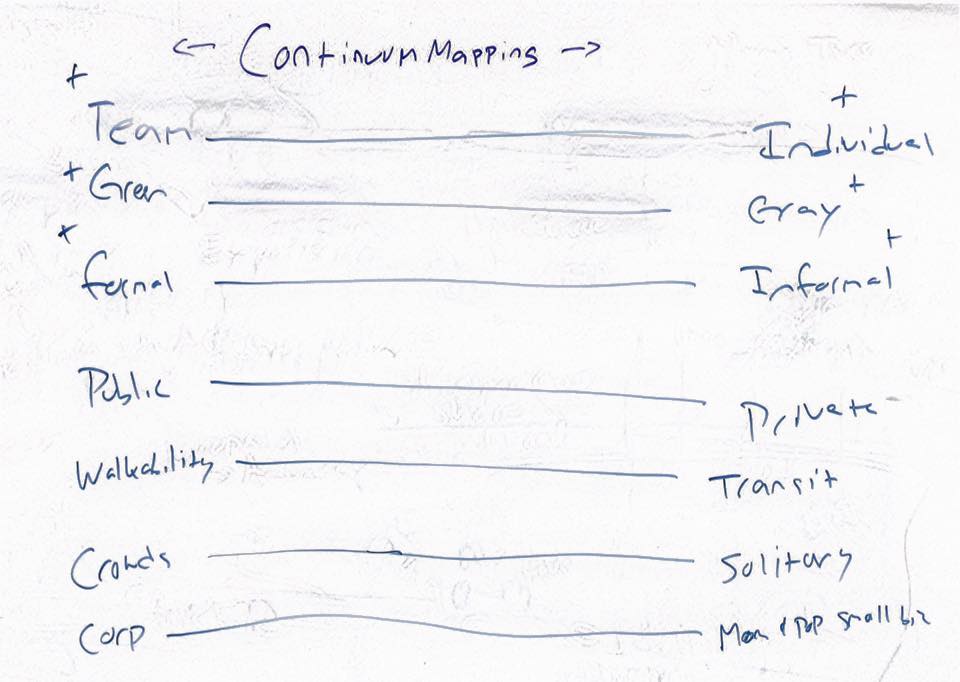
Continuum Mapping :: Corporate Team Development
Outcomes & Objectives:
- Dialog with a team on how they view a challenge, opportunity, or space
- Shared understanding of what a team accepts, it must also reject some aspect
- Understanding and dialog of how each person and the collective group views a challenge, opportunity, or space
Materials:
- Masking tape
- Index cards or metaphor cards
- A list of choices that are not clear either-or solution … see examples in preparation
Group Size:
- 3 to 5 per/group
Time Frame:
- 45minutes – 1hour
Preparation:
Frame the challenge, opportunity, or space. The choices will be helpful when there is no clear ‘best’ option; instead, the group must acknowledge both / all options are helpful and wants to determine what may be appropriate at that time.
- Challenge: a current problem that the team has to solve.
- Opportunity: a current chance for growth, progress, or success is in front of the team.
- Space: the use of physical space and how it may be changed and seen as a challenge or opportunity.
On each table, tape index cards on the extreme opposites. These cards will serve as poles for the continuum choices.
Develop a list of continuum choices appropriate to the group and discussion.
Team <——————–> Individual
Authority <—————> Autonomy
Wake up early<———–> Sleep in late
Take responsibility <—–> Delegate responsibility
Formal <——————–> Informal
Confront <—————–> Yield
Family <——————–> Individual
Group <——————–> Solitary
Complex <—————–> Ordered
Integrated Leadership Model (Browne 2008)
Task <———————-> Person
Flexible <——————> Dogmatic
De-centralized <———> Centralized
Rewards <—————–> Punishment
The means <—————> The ends
Structured <—————> Organic
Write the continuum options on index cards and tape the cards on opposite sides of the table. Or, have the choices on power-point slides that you will guide the group through as needed.
If you choose to use the metaphor cards, place them face-up (image up) on a central table.
Instead of using metaphor cards, you can ask people to take an index card and write their name on the index card.
Instructions and Facilitator Script:
Please discuss with the group the objectives of the time and what they are doing together. Share the challenge, opportunity, or space you will explore as a group. Allow for some questions and clarification about the topic. Try to avoid decisions or details; you are just trying to better clarify the topic for discussion.
Using metaphor cards
- Ask people to gather at the table with the cards. They will choose 1 card they like, place a piece of masking tape on the back of the card and write their name on the tape.
Using index cards
- Ask people to grab an index card and write their name on the card.
- Explain continuum. With many choices, two possibilities exist together (a paradox). Neither is better or worse; more or less, they are both appropriate based on space, context, and choice.
- Ask the group to break into teams of 3 to 5. Create groups or allow them to self-select
- Share the first continuum with the group. It is best to share an easy example like Mac <—> PC or Wake up early <—> Sleep in.
- Using their index or metaphor card, each person will place their card on the continuum where they feel comfortable. If you are an extreme PC, you will be closer to the side that is PC; if you are somewhat undecided, you will be closer to the middle.
- Once they have settled on where they fit along the continuum, ask them to observe where others are about themselves. Ask them to share with a partner what factors led them to choose their location on the continuum. Ask the group to observe where the largest masses of responses are on the continuum, where each person is about them, and what this may mean for the group.
- Continue on the next continuum and follow steps 4 – 5 again.
Processing and Reflection:
Once you have gone through the continuum to gather enough information and the group has discussed the topic enough, it may be helpful to ask the group some of the following:
- Based on our continuum discussion, what was helpful?
- How much better do we understand the topic?
- Seeing others’ perspectives can help us understand our views; how has your perspective changed today?
- Can you share an example from our continuum today where you may choose the opposite with a small change in context?
- What do you feel is a progress step to better capture our challenge, opportunity, or space?
References
Browne, M N M (2008) An Integrated Model of Leadership, Ph.D. thesis, University of Hull, UK
_______________________________________________________

